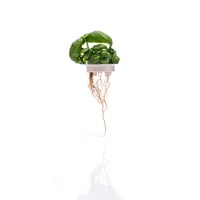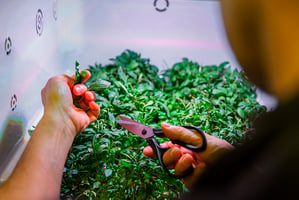In recent years, hydroponics has become one of the most studied, adopted and discussed growing...
4. The main hydroponic systems explained (NFT, DWC, Ebb&Flow...)
Introduction
When people talk about hydroponics, they tend to use the term loosely. In reality, there are very different technologies behind "soilless cultivation," each with specific advantages, limitations and applications. Knowing the main systems is crucial to choosing the right system, avoiding wrong investments, and setting the cultivation strategy correctly.
In this article we take a technical but accessible look at the most popular systems: NFT, DWC, Ebb&Flow, aeroponics and drip systems.
Where applicable, we also highlight how Tomato+ solutions integrate the most effective principles of these models, optimizing them with automation and AI.
1. NFT - Nutrient Film Technique
How it works.
Roots grow in slightly inclined channels, traversed by a thin film of continuously recirculating nutrient solution.
Advantages
-
Excellent natural oxidation (very aerated roots).
-
Low volume of water required.
-
Excellent yield for lettuces and baby-leaf.
Disadvantages
-
Low tolerance to setbacks: a pump blockage = rapid collapse.
-
Not suitable for very heavy or large-rooted plants (tomatoes, zucchini...).
Ideal Use.
Light rapid-cycle crops.
How Tomato+ interprets it
Tomato+ greenhouses use concepts derived from NFT controlled flow, but in a closed, automated, sensor-monitored version, eliminating the risk of water stress typical of open systems.
2. DWC - Deep Water Culture
How it works.
Roots are immersed directly in oxygenated water via aerators or recirculation systems.
Advantages
-
Extremely stable.
-
Ideal for crops that require a lot of water.
-
Rapid growth due to continuous availability of nutrients.
Disadvantages
-
Risk of low oxygenation if not managed properly.
-
Water to be kept in range (temperature, EC, pH) at all times.
Ideal use.
Medium to large plants, vigorous herbs, prolonged growth.
How Tomato+ interprets it
Our Hortos integrate sensors for temperature, levels and water quality, automatically correcting parameters and oxygenation. The user does not have to manually manage aerators or recirculation-the system regulates everything.
3. Ebb&Flow - Marée system (filling and emptying).
How it works.
The growing tray fills and empties cyclically with nutrient solution.
Benefits
-
Excellent natural oxygenation.
-
Compatible with many types of substrates.
-
Reliable and easy to control.
Disadvantages
-
Poorly set cycles can create water stress or salt buildup.
-
Greater complexity than DWC.
Ideal Use.
Ornamental plants, crops with developed roots, small multi-species plants.
How Tomato+ interprets it
Tomato+ uses similar concepts to manage smart cycles: the AI adjusts frequency and duration of flows based on variety, growth status, and actual plant response (monitored by camera and telemetry).
4. Drip Systems - Drip Irrigation Hydroponics.
How it works.
Nutrient solution is delivered via controlled drippers.
Advantages
-
Extremely flexible.
-
Excellent for large plants and fruiting.
-
Ideal in professional cultivation.
Disadvantages
-
Risk of occlusion of drippers.
-
Needs careful management of drainage.
Ideal Use.
Tomatoes, peppers, strawberries, cucurbits.
5. Aeroponics - advanced level
How it works.
Roots are suspended and sprayed with nutrient solution.
Advantages
-
Very high oxidation → very rapid growth.
-
Maximum precision in nutrient delivery.
Disadvantages
-
Very sensitive to failures (nozzles, pressure, pump).
-
Requires high technical level.
Ideal use.
Research, experimentation, high-tech systems.
How to choose the right system
The choice depends on three key elements:
1. What you want to grow
-
Lettuces: NFT
-
Aromatics: DWC or hybrid systems
-
Fruits: drop
-
R&D: aeroponics
2. How much control do you have over climate
Indoor → more flexibility
Outdoor → better systems that are less sensitive to variation
3. How much automation do you want
More automation = less human risk = more stability
And this is precisely where Tomato+ comes in.
The Tomato+ approach: an integrated ecosystem
Tomato+ combines the strengths of different systems - controlled flow, optimal oxygenation, continuous monitoring - into a single automated platform, which:
-
regulates EC, pH, temperature, and photoperiod autonomously
-
uses AI to optimize crop cycles
-
offers varieties in ready-to-use pods
-
reduces the risk of human error to virtually zero
It is a model that brings advanced hydroponics to anyone, without requiring technical expertise.
Conclusion
NFT, DWC, Ebb&Flow, drip systems and aeroponics are different tools for different goals. Knowing them allows you to choose the most efficient strategy and to understand how an integrated system like Tomato+ manages to combine the advantages of each while eliminating their complexities.
Thank you for reading this article. Keep following us to discover new content on hydroponics, vertical farming, and smart agriculture.
Tomato+ Team


